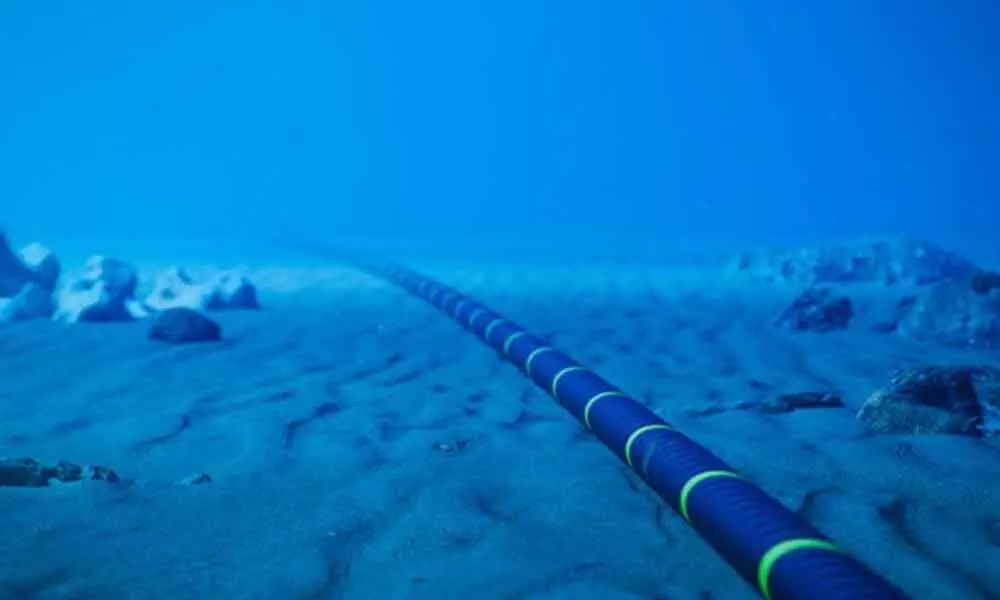Live
- India Faces Blow as Pacer Mohammed Shami Ruled Out for Remainder of Australia Series
- Biden Pardon: Joe Biden Commutes Death Sentences of 37 Inmates, Including Child Killers and Mass Murderers
- South Korea: Yoon believes impeachment trial takes priority over martial law probe
- Strict Action for Non-Adherence to Time Management - DMHO Dr. Swarajya Lakshmi
- Over 13.29 lakh houses approved for rural poor in Maharashtra: Shivraj Chouhan
- District Collector Urges Timely Completion of Indiramma Housing Scheme Survey
- Digital Arrest Scam: Hyderabad Man Duped of ₹7 Lakhs by Fake Crime Branch Police Callers
- Sukhbir Badal seeks President's Police medal for officer who saved his life
- US Firm Accordion Acquires Merilytics, Launches 1,500-Seater Office in Hyderabad
- Free Medical Camp Organized by Alampur Advocate Bar Association
Just In
How Tonga's Broken Internet Cable Will Be Fixed?


How Tonga's Broken Internet Cable Will Be Fixed?
An undersea fibre optic cable connecting Tonga to the rest of the world was broken during a volcano eruption. The underwater eruption, followed by a tsunami, caused the 110,000 inhabitants of Tonga to be isolated.
New Zealand's Foreign Office says it could take more than a month to repair all 49,889 km (31,000 miles) of cable in the South Pacific.
The underwater eruption, followed by a tsunami, caused the 110,000 inhabitants of Tonga to be isolated.
A 2G wireless connection is established on the main island, using a satellite dish from the University of the South Pacific. But service is patchy, and internet services are slow.
How will the cable be fixed?
The cable, operated by Tonga Cable, is believed to have broken about 37 km (23 mi) offshore.
As per Reuters, fault detection was carried out by the company after the volcano appeared to confirm a broken cable.
According to Virgin Media Principal Engineer Peter Jamieson, the repair process is relatively simple, who is also vice president of the European Submarine Cable Association.
"They will send a pulse of light from the island, and a machine will measure how long it takes to travel and this will establish where the break is," he explained.
A cable repair boat will then be dispatched to the site of the first break.
You will use an ROV (Remotely Operated Underwater Vehicle) or a tool known as a grapple (basically a hook on a chain) to retrieve the broken end.
That will reattach to the new cable on board the ship, and then the same process will happen at the other end of the landing. The entire process will take around five and seven days if all goes well.
Why might it take longer?
It will take time to get a cable repair ship to the archipelago, and the closest one is currently stationed in Port Moresby, Papua New Guinea, some 4,700 km (2,900 miles) away.
The specialized ship, The Reliance, sails more than 50,000 km (31,000 miles) in the South Pacific.
Experts will have to determine that the area is safe for the ship and crew and no more volcanoes erupting.
Do these cables break often?
It is estimated that up to 200 repairs are carried out each year worldwide, but natural disasters that cause them are rare. 90% of breakages come from the nets or anchors of fishing boats.
Increasingly, tracking technology is being used to alert operators to any vessels in areas that may pose a hazard to cables, so they can be contacted directly to warn them.
Data cables are made of glass fibre optic strands, but much of the thickness of the cable is just a protective covering for the glass strands.
Cables that run over a continental shelf must be buried between one and two meters deep. However, many simply lie on the ocean floor because they are too deep under the sea to be harmed.
The exception to this is natural disasters, as happened in Tonga. In 2006, an earthquake off the coast of Taiwan snapped a cable and caused the loss of international phone services and Internet in the region.
How crucial are these cables?
In western countries, if a cable breaks it is not a problem, because there are many others. For example, the UK has around 50 cables feeding data into the country.
In Tonga, there was just one. "Ideally you would have at least two cables as a minimum," said Mr Jamieson. "But cables are expensive and there is no drive for Facebook, Google or anyone to build one there."
Across the globe it is expected that there are more than 430 cables, spanning distances of 1.3 million kilometres (800,000 miles).
After a previous cable break in 2019, from a ship's anchor, Tonga signed a 15-year deal to gain satellite connectivity. But the satellite phones usage has been affected by the volcanic ash covering the country. Some people have reported that they can only dial and not receive calls.
Due to cost, the use of satellite phones is limited to government officials and some businesses. Mobile network provider Digicel has set up a makeshift system on the main island of Tongatapu, using the University of the South Pacific's satellite dish to provide limited 2G coverage.

© 2024 Hyderabad Media House Limited/The Hans India. All rights reserved. Powered by hocalwire.com






